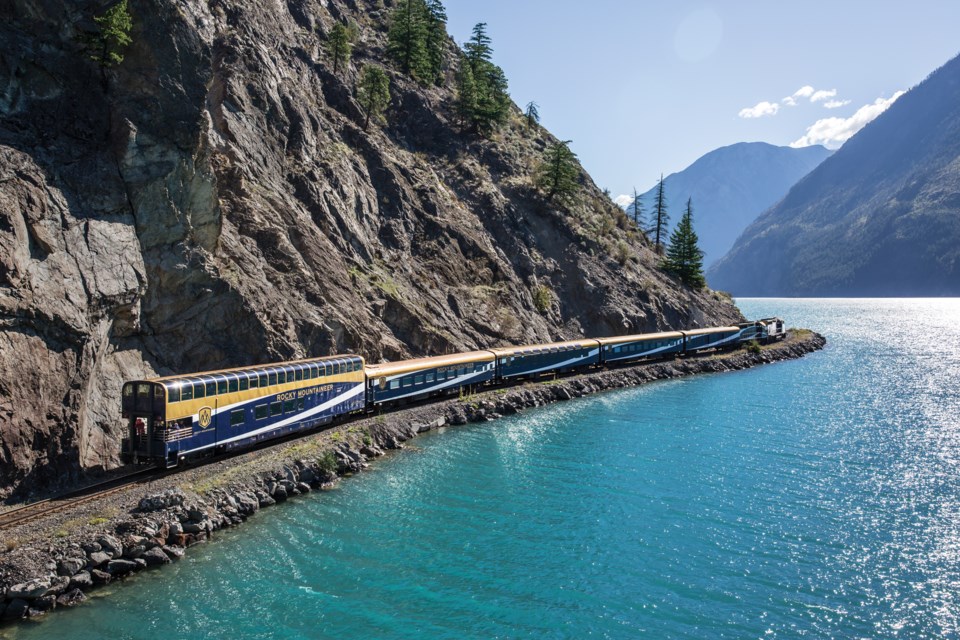I miss the trains rolling into Whistler. The clack and clang as the cars pulled into Alta Lake would shake off morning slumber. Off I would step, somewhat fresh and mostly rested, rolling and ready for a day in the mountains.
But more often than not, I was stumbling, exhausted from a long car ride. I cut my teeth driving Highway 99. With my freshly printed driver’s licence in 1996, I carefully threaded the family Dodge Caravan—wood panelling and all—up the winding ribbon of icy turns and twists every Friday night. We were weekend warriors, dedicated to driving up and down the headlight roller-coaster no matter the weather.
It wasn’t always a good idea.
Long lineups were common as cars slipped and slid, as were deadly head-on crashes and spin-outs off (or into) cliffsides. We always arrived in Whistler feeling somewhat seasick—the old highway was narrow, filled with blind corners and hairpin hills, and we felt lucky to be alive after surviving yet another nail-biting snow storm.
But driving wasn’t the only option. See, not so long ago—indeed, right up until the collapse of the Dot Bomb era—we had passenger rail service across the province, all thanks to Crown corporation BC Rail. From the early 1900s to the turn of the millennium, we had commuter trains connecting North Vancouver to north of Lillooet and points-in-between, from D’Arcy to Seton Portage. It was simply amazing throwing skis in the train car, scrambling aboard, hearing the whistle and rolling into Whistler.
No stress. No sick drives. No crazy crashes.
Travel was affordable by today’s standards, and the trains were used by everyone from skiers and sightseers to vagabond locals alike.
But then we lost it all. In 2003, Premier Gordon Campbell’s Liberals privatized BC Rail, leasing its assets for decades to CN.
The Sea to Sky is a tremendous tourist draw, and as we all know, our population is growing fast. It is clear that along with affordable housing, we need accessible, safe, and affordable transportation that connects the corridor. With the Feds in “nation-building” mode, now is our chance to secure infrastructure funding to make passenger rail happen, at a scale and scope long seen in the Alps.
Back before the 2010 Olympics, we were hoping to see future-thinking improvements to our transportation network. The big money was rolling in and we hoped trains would, too. Many of us wanted the restoration of passenger service, but thanks to Campbell’s short-sighted austerity politics, CN had its chokehold lease on the lines. So we got the new highway instead. This, too, needed to happen—not the least because now there’s less chance of it collapsing into Howe Sound with a slight tremor. But we still didn’t get our trains back.
So even though ol’ 99er is a tad more pleasant to commute at high-speed, little else has changed—save for losing all the other means of transportation. As astute readers (and commuters) know, we have had difficulty instituting a regional transit system. And in 2025, deadly crashes remain a constant concern. Increased tourist traffic has eaten up what extra lane space the Olympic upgrades provided. And while objectively the highway is “better than it used to be,” it is also true that getting to Whistler can be just as bad, if not worse, than it was before.
Today, most tourists step off a plane to a dark and rainy Vancouver, and sleep-deprived, dazed and confused (if not boozed), they are handed the keys to a heavy SUV. Speeding north up the unrelenting highway, white-knuckled on the wheel while searching for the few lane markings and all-but-absent cat-eyes, you can see our visitors cursing the unlit corners as us locals try to pass. It’s a recipe for disaster, and that disaster strikes with deadly force several times a year. So why are we still treating Highway 99 like DeathRace 2000, especially when we have practically everything in place for passenger rail?
I know folks will point out the immense cost of upgrading the lines and terminals. But we already paid for all this before (dammit)—so what we need right now is public pressure based on collective vision, and not more narrow-minded naysayin’.
Moreover, what is the cost of all those crashes, lawsuits, and damaged lives from the car-wrecked carnage?
Forget handing over the keys. I want tourists to step off that plane onto a luxury train, and not into another sketchy SUV. We had it all before—there was the Pacific Starlight dinner train, which ran romantic romps to Porteau Cove, and the Whistler Northwind, a luxury excursion caboose that ran summers to Prince George. Nothing beats railcar swank for its spaciousness and style. The future of transportation was already invented centuries ago and nothing has yet to beat its charm. As an ’80s kid, I rode the Royal Hudson, a beautifully restored 1940 steam locomotive that puffed and chugged all the way up from North Vancouver. Scenic and slow, the sound of No. 2860’s steam whistle still echoes deep in my memory…
And here’s the thing: BC Rail was profitable. Sure, the passenger rail was subsidized with profits from commercial transport. But that was the point: to make travel affordable for all of us. Provincially and federally, for generations, successive governments invested in BC Rail. The public rode BC Rail. And for close to a century we had fantastic passenger rail service until Gordo’s Liberals decided, in their infinite back-scratchin’ wisdom, to sell us all out.
And sell us out they did, even though public opinion was solidly against the dismantling of BC Rail.
I still have my pin from the era, featuring Drunk Drivin’ Gordo’s face and the GenXer cynical refrain of “WE’RE FUCKED.” It was hardly hyperbole. Our premier had been booked drunk in Hawaii, and with his mugshot still in the papers, went about selling off our provincial assets piecemeal. This was the era of austerity politics posing as a public good. Under neoliberal doctrine, we were told “the market” would provide better service and more competition than government ever could.
But guess what. Leasing the rail lines to CN for decades did not create more competition or services. It created a corporate monopoly, with no means to pressure for public service on our publicly-developed-and-paid-for rail lines. Sure, Rocky Mountaineer kept a train going, but it was marketed and priced for sightseeing tourists, not local travel.
Passenger rail is just what Whistler needs as we look forward to a climate-challenged century. We need the ability to move goods and people with energy efficiency. And we need to free our roads of sleep-deprived drivers. Me, I want to be able to hop on a train after getting ripped on a flight. I want to roll into Whistler the right way.
Dr. tobias c. van Veen taught critical humanities and social sciences at Quest University (RIP).




